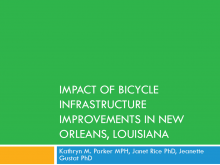We are pleased to announce an exciting new alliance between Active Living Research and GP RED to co-host and coordinate...
Ready to Ride: Impact of Bicycle Infrastructure Improvements in New Orleans, LA

Presentation at the 2012 Active Living Research Annual Conference.
View the associated research paper.
Background
Regular exercise and a healthy diet can help people achieve a healthy weight. Active transportation, such as biking and walking, to meet daily needs such as shopping and going to work or school, is one way for people to fit regular exercise into a daily schedule. Changing the built environment by adding bike lanes can encourage more children and families to become physically active. Devastation caused by the hurricanes of 2005 created a unique opportunity to rebuild streets in New Orleans, LA, and make them safer for cyclists. The New Orleans Department of Public Works and the Louisiana Department of Transportation and Development worked together to create a 1.2-mile bike lane on South Carrollton Avenue in Uptown New Orleans. The bike lane was constructed 5-feet wide and located between the parking lane and the outside travel lane. Previous research conducted on other bike lanes in New Orleans showed increases in the number of people using bike lanes, but results were limited by a lack of comparison streets.
Objectives
This study examined the impact of building new bike lanes in New Orleans though direct observation of one intervention street with a new bike lane and two comparison streets without bike lanes. The main objectives were to determine: (1) whether more people are cycling after the bike lanes were built; and (2) whether more people ride on the street rather than the sidewalk and with the flow of traffic after the bike lanes were built.
Methods
In September 2009 (mean temperature 79.4°F) and September 2010 (mean temperature 78.1°F), trained observers conducted manual counts of cyclists riding on South Carrollton Avenue, where a new bike lane was built in June 2010. Concurrently, observers counted cyclists on two adjacent side streets where there are no bike lanes. The observation location on the intervention street was directly adjacent to a public school that housed kindergarten through eighth-grade students. Cyclists were counted riding on the street (both in and outside of the bike lane) and sidewalk, with and against traffic, before and after the bike lanes were built. All observations were categorized by gender, race and approximate age. Data were collected continuously over a one-week period for each location for 11 hours from 7 a.m. to 6 p.m., five days a week (Tuesday, Wednesday, Thursday, Saturday and Sunday). During periods of light rain, observers continued to take data, but if rain was heavy, observations were canceled for that day and rescheduled for the same day of the following week. Differences were tested with Poisson regression and logistic regression, with a p-value of 0.05.
Results
Data showed more people cycling per hour on all streets combined after the lane was constructed on South Carrollton [4.2 (+ 3.1) vs. 6.3 (+5.1), p<0.000]. Baseline data showed an average of 3.4 (+2.4) riders per hour on South Carrollton and 4.9 (+3.5) on side streets. The average number of cyclists on South Carrollton increased from baseline to follow-up [mean 9.2 (+5.1), p<0.000], but decreased on the side streets [mean 3.1 (+2.6), p<0.000]. The increase in the number of riders on South Carrollton (in absolute value) was larger than the decrease (in absolute value) on the side streets (Z=7.62; p<0.001).
The proportion of people observed cycling on the sidewalks changed differently for South Carrollton and the adjacent side streets. Fewer people were observed riding on the sidewalks on South Carrollton after the lane was installed, though the differences were not significant (pre 9.33, post 7.89; p=0.23). There was a significant increase in the number of people observed riding on the sidewalk on the side streets after the lane was installed on South Carrollton (pre 1.23, post 5.46; p<0.001).
After the bike lane was constructed on South Carrollton, the proportion of riders observed traveling with the direction of traffic increased (pre 92.8%, post 95.8%; p<0.002) on the intervention street. However, the proportion of people traveling with traffic on the side streets decreased (pre 96.3%, post 93.7%; p=0.013).
Additional analysis describing age groups, gender and race of observed street and sidewalk riders will also be presented.
Conclusions
Bike lanes can have a positive impact in creating a healthy community. Installation of bike lanes can increase the number of cyclists in a neighborhood. Streets with bike lanes will attract more cyclists than streets without bike lanes. Installing bike lanes on roads can be a low-cost mechanism to improving physical activity in urban areas.
Support/Funding
- Robert Wood Johnson Active Living Research Rapid Response Program (grant #67306).
- The Prevention Research Centers Program of the Centers for Disease Control and Prevention (Cooperative Endeavor Agreement #U48-DP-001948).
- ASPH/CDC Environmental Health Scholarship.
- HRSA MCHB Maternal and Child Health/Epidemiology Doctoral Training Program (Grant T03MC07649).
- DOWNLOAD "2012_InterventionPlanningEval_Parker.pdf" PDF (2.23 MB) Presentations
Related Tools & Resources
STAY UP TO DATE
RECENTLY ADDED TOOLS & RESOURCES
MOVE! A BLOG ABOUT ACTIVE LIVING
The "Active Living Conference" aims to break down research and practice silos and...







